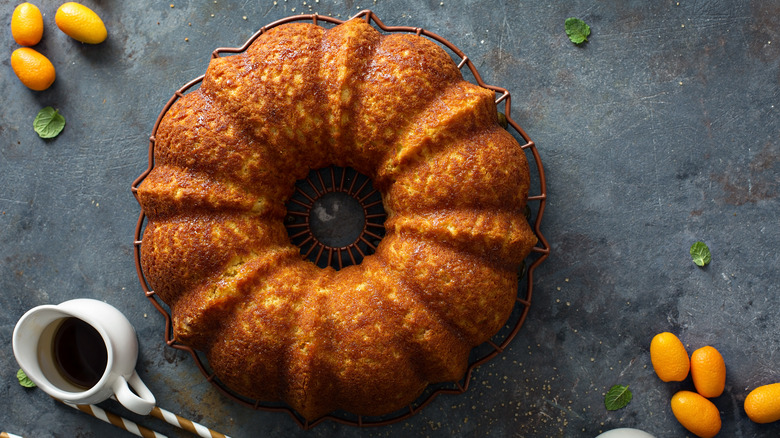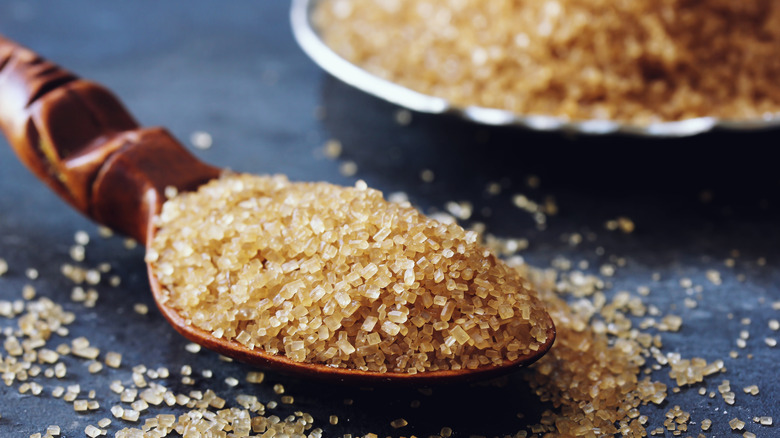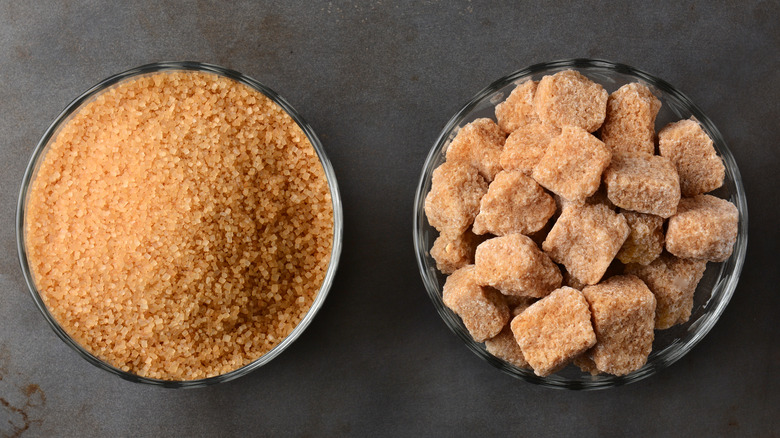The Ingredient That Gives Ina Garten's Pound Cake A Crackly Edge
Among other things, Ina Garten is an incredible baker. The Barefoot Contessa's culinary know-how truly shines in this category, and she has two different approaches to making pound cake, which are both featured in her cookbooks. In "Cooking For Jeffrey," her vanilla cream cheese pound cake is a classic take on the beloved confection — whereas in her book "Barefoot Contessa Foolproof," she switches things up in her aptly named perfect pound cake by substituting heavy cream for the cream cheese. Both result in dense, rich, and impossibly buttery delicious cakes. The one ingredient that elevates them both from ordinary isn't on the inside — it's what's on the outside.
Before pouring the cake batters into their pans, she completely coats the insides of them with turbinado sugar. This results in the most amazing crackly crust all over the cake surfaces and edges. The turbinado sugar crystals heat up into a golden and exquisitely crunchy golden outer layer, which — combined with the pillowy, crumbly cake within — is nothing short of a textural and taste masterpiece. It's so delightful that you'll want to eat this magic crust on everything. The great thing is that you can easily copy Ina Garten's technique and apply it to just about any cake or baked good for your own slice of homemade sugary heaven.
The sweet secret to crispy crust
To create your own sweet and crispy finish on any cake, simply follow the Barefoot Contessa's lead. The trick is in how you'll prepare your pan. Ina Garten's pound cakes can be made in either a Bundt cake pan or split into loaf pans, but you can use whatever the recipe you are following suggests. First, you'll need to grease the pans. Garten recommends a baking spray with flour, but you can get away with your preferred cooking spray, or even butter ... the idea is to make the inside of the pan non-stick as well as to give the sugar something to adhere to.
Next, sprinkle a generous amount of turbinado sugar into the greased pan. She uses ¼ cup to fully coat a 12-cup tube pan, but there's no reason you can't use more for a thicker and more delectable finish. The idea is to make sure that every bit of the pan is completely coated in the sugar. Tilt the pan around to shake the sugar onto every nook and cranny of the pan; this even coating is what will get you those gorgeous crackly edges. Proceed with the rest of your recipe as usual and remove your cake from the pan carefully to avoid dislodging the yummy crust.
You can also use this same method on cupcakes and muffins, too. Skip the paper liners, grease the tins directly, cover in sugar, add batter, and thank us later.
The difference between turbinado and demerara sugar
Turbinado sugar is made from sugar cane, but that's where its similarities to regular white sugar end. White sugar is refined through a series of boilings that remove its color and natural molasses; turbinado, on the other hand, is the first press of cane juice, which is only boiled once, a process that creates those recognizable large crystals. The crystals get dried in a spinning centrifuge, essentially a turbine, which is how turbinado got its name. The result is raw, brown-colored sugar — not to be confused with actual brown sugar, which is white sugar with molasses syrup. Because turbinado doesn't melt as quickly as processed sugar, it's more often used as a finishing sugar rather than as an ingredient that blends or dissolves. Its big crystals add a lovely, sparkly decorative touch that's desirable for its unmistakable crunch.
Demerara sugar is sometimes confused for turbinado, which is understandable as they are quite similar. Turbinado is the least processed of the two, so it retains the sugar cane's inherent molasses, which comes through as a caramel flavor. Demerara sugar is more refined and with smaller crystals and less molasses in the final product, giving it more of a toffee-like taste. While turbinado's larger grain provides the maximum amount of crunch, there isn't a significant flavor difference between the two, making them interchangeable. Ina Garten says that you can use either one to achieve her mind-blowing crackly-edged cake effect. How easy is that?



